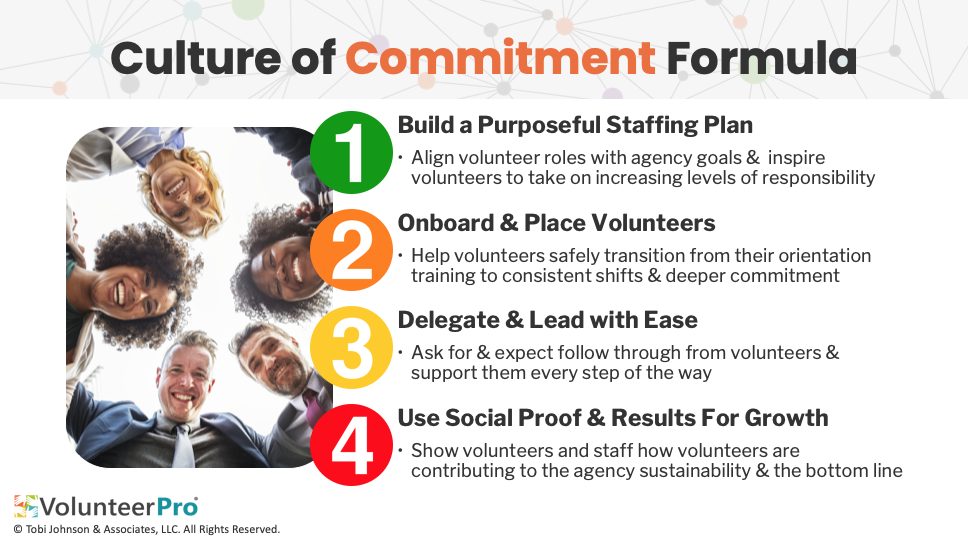 Managing Volunteers in 2020: You Need to Do Less to Do More
Managing Volunteers in 2020: You Need to Do Less to Do More
As we approach the new year you tend to reflect on what you’d like to achieve when managing volunteers — whether it be a refreshed web site, a new training series to create and market, conferences to attend, networks to connect with, etc., etc. — and it can start to feel overwhelming.
Next thing you know you’re feeling anxious. How can I possibly get all of it done? Will anyone even support what I want to do? Or, will I be left holding the bag… again?
Just the thought of it may tire you out, and you haven’t even begun!
So, how about taking a different approach? How about instead of a long laundry list of resolutions for the new year, how about simplifying?
I am NOT saying let’s continue to struggle and “do more with less.”
What I AM saying is instead, let’s try to “do less so that we can do more.”
In others words, let’s focus more on that 20% of work that can get us the best results in the new decade, instead of spinning our wheels on things that suck up time, but don’t contribute to our end goals.
I talk to a lot of people in the nonprofit world and many are in the same boat. They feel overstretched and overwhelmed. It’s pretty much our constant state of being, right?
So, what can we do about it? My answer? Do nothing.
Well, not exactly “nothing,” but why not give this a try. This New Year, instead of making your traditional list of resolutions, make what I call REVERSE RESOLUTIONS.
In other words, instead of adding to your “to–do” list find things you can REMOVE.
What will you do less of this year? What can you take off your plate? What will you ignore? What will you decide not to achieve? What will you walk away from? 
It sounds radical, but it makes sense. If you’re like many of the mission-based organizations across our nation, you’ve been asked to do more with less. In response, you may have diligently found more volunteers, tried more efficient ways of doing things, and even cut a few programs.
All well and good.
But there is a tipping point. A point where you, your staff, and your volunteers are burned out and ineffective.
Are you there yet? Are you getting close? If so, give yourself a break. Set some reverse resolutions for you and your team. Better yet, set them in collaboration with your team.
It’s liberating, invigorating, and may even be the key to your sanity and survival.
6 Tips for Setting Reverse Resolutions
Below are six things you can do to focus your energies on what’s working and leave the rest behind.
Tip #1: Align Real Activity with Real Goals
Focus on what’s mission-critical (either personal or organizational) and cut out the rest. Revisit your mission statement, your strategic plan, and any grants that fund you to remind you what you should be driving toward.
Tip #2: Say No to Projects that Don’t Get You Traction
Have the courage to take a closer look at your pet project(s). Are they contributing to your bottom line, or are they a diversion?
This is a hard one. The reason you may have taken them on in the first place is for the mental or emotional relief they offer. If you can successfully simplify, you may be able to reduce the pressure that makes these projects necessary.
Tip #3: Reduce Duplication of Effort
If someone else in the community, agency, or team is offering the same product or services (or doing the same tasks) equally as well as you or better, consider dropping that task and finding a way to partner. For example, if human resources staff does employee background checks, can they also conduct them for volunteer applicants?
There may be greater efficiencies realized when teams can batch similar work. There’s no need to be territorial. You have bigger fish to fry.
Tip #4: Prioritize for People Who Can’t or Won’t
While your team may welcome the simplification, your funders or upper management may not get it. Your boss may be accustomed to sending you directives without any formal prioritization, making it a challenge to decide what should stay and what can be removed.
You can make some executive decisions about what you’ll tackle based on 1) your mission, 2) community need, & 3) resources at hand. But, be ready to explain your choices and then get on with it. Focus on exceeding outcomes in your priority area(s) and let the rest take care of itself.
The alternate is to require your undisciplined boss to clearly communicate their priorities by asking them to rate your to-do list. Explain that you are seeking to spend the majority of your time on work that will actually have an impact and that you need their help culling your list down. This is a smart strategy when you need to say “no” to a colleague for a future ask. Your boss will be already bought into your streamlined list because they helped you build it and they signed off on it.
Tip #5: Remember … YOU Control Your Day 
Even though it feels like others control how we spend our time, is that really true? You can make conscious decisions about how you respond to interruptions, when you check email, even which meetings you attend (at times, anyway).
You can even choose a reverse resolution each day and make it work for you.
Tip #6: Scare Yourself a Little & Celebrate Yourself a Lot
You simply cannot grow if you are not stretching yourself as a leader. So, give yourself permission to take some bold steps.
Yes, you will need to slay some of those sacred cows as you re-engineer your workload. Acknowledge this. There will be some tension inside yourself as you try a new way.
To manage your inner demons, focus on what has real meaning. Reduce the clutter for your well-being. You deserve it, and we need you for the long run.
4 Key Places to Focus Your Efforts
You may be wondering where to focus efforts for the most traction in your volunteer engagement.
In my free VolunteerPro Volunteer Management Academy online course The Art & Science of Volunteer Accountability, I talk about four areas of managing volunteers that have the most impact on whether volunteers stay and are productive.
They include:
- Staffing plans
- Volunteer onboarding
- Delegation and leadership
- Social proof and impact communications
The Culture of Commitment Formula

If you’re seeking to reduce turnover rates and deepen the commitment of your volunteer corps this year, then these are areas that make sense to focus your energies on improving through better systems and strategy.
If your main challenge is finding volunteers, you may want to shift some of your focus to marketing and communications.
But don’t completely neglect volunteer retention efforts. Good retention results will make your recruitment soooooo much easier later on.
Now, Write it Down
What’s ONE thing you’re going to do to simplify the next year? Write it down and post it in a spot that’s easy to see. You’ll be more likely to take action.
I wish you all a simple, peaceful, and prosperous New Year.
Thanks for reading and sharing.







Leave A Comment